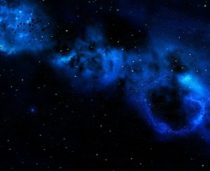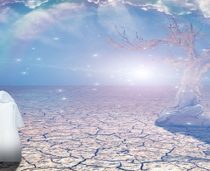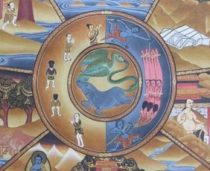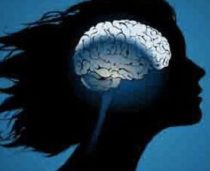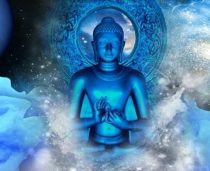Boundless Luminosity, the key to it, as far as I can see, is the self-similar nature of the patterns themselves, and I think it’s the patterns themselves and the movement of energy and information and all the different factors that we have going on that generate the consciousness, where the consciousness generates these things.
At any rate, they definitely seem to coexist.
Fractals, that’s where descriptions of the self-similar come in.
So what we’re looking at here is a universe of patterns similar to other patterns, without being identical, but nevertheless similar.
If you take genetics, all of the genes are made up of four molecules, so it’s a very simple repeating pattern.
Although these four molecules show up in different orders and perform different functions, this pattern of using these four molecules repeats throughout all of what we call life. So there are different numbers and different configurations of them, but nevertheless, it’s the repetitive nature of these things.
I believe these things themselves are responsible for probably trapping and maneuvering the energy and in some way the information that’s going through the universe.
I’m certain that they’re conducting various types of electromagnetic information that’s there to communicate with the other parts of the cell, and that information crates the reactions that they have and causes the structures that they build and they ways that they communicate with other cells and take in chemicals and impulses and whatever it is they’re doing.
If it’s a nerve cell, it’s going to be an electrical impulse.
If it’s another kind of cell, it could be probably an electrical impulse coupled with responses and reactions to different hormones and other contents in the blood, whatever building blocks or fuels are available to it.
It’s usually those things, with each cell having its own way of doing that, types of cells doing it similarly to one another, all of them doing it similarly to each other in a general way, and then the more specific ones doing it just as we find in every structure that we can think of.
We have a tree. We have a system of roots. There are the main roots, and here are branching roots. There are roots that are working more with oxygen and roots that are working more with water.
Different types of things are going on. There are the growing tips of the roots. There are all these different functions happening, and the same thing happens in all bodies and everything else.
Even in organizations larger than that, we find these same kinds of self-similar principles occurring in families and in businesses.
There are central figures, and then there are ancillary figures, each having their own duties and their own bit to contribute in organizations such as businesses or groups.
The same kinds of patterns exist.
So we can see this going on, doesn’t it also then make sense that if we can go in either direction, we can go up or down?
We can go into the solar system, which has a particular type of an organization, each of the planets has an influence on the other planets rotations and other types of things. This information may have some consciousness.
We don’t know that all of the electromagnetic fluctuations and gravitational fluctuations aren’t communicating in some way with surrounding stars and in a larger sense galaxies communicating with galaxies. We do know that some of the galaxies are in clusters, and some stars are in clusters, binaries, and other types of formations.
So there’s clearly material being exchanged.
What we see in our world, at this level, is if you’re exchanging material, then you’re exchanging other kinds of information also, even unintentionally.
So if we ship a bunch of cargo from one part of the world to another, we often take sea going creatures with it, maybe we take cats, rats, and who knows what else, any number of diseases, or any other kind of thing might be riding along with it.
One could assume that the same may be true for one star that’s merging with another star or what happens during a supernova in the surrounding areas.
We know that that must have some effect. We’ve felt the gravitational effect of something that happened several billion years ago recently, the two black holes.
So that’s a gravitational shift, which means it’s a shift in the time space continuum. That meant that time shifted for everyone and that little blip was everyone moving just a touch closer to the two black holes, which is a single black hole now. That was a tug. That was something that happened to the galaxy.
These things are going off all the time, in different places and in different galaxies all over the place, so this is just one of the things that happen.
There’s a lot of thought about whether or not the black holes would consume the universe, and now there’s a lot of thought that says that black holes doing have enough gravity to consume the universe. The universe will not be actually eaten by the black holes. It will be distributed too far and wide for the black holes to take in. I’m not sure about that.
Man: They have a couple of ideas. One of the latest ideas I’ve heard was the “Big Rip” that as the universe expands it speeds up. There will come a time where the speeding up will surpass the speed of light, and then reality will rip. Space-time will just rip like a garment. It’ll get pretty wacky at that time.
DJ: So I’m thinking more as something similar to what we already know.
More like perhaps a life-form. Certainly it’s processing a lot of information, and it would make sense.
If it’s a life form, it would have some sort of an ending, other than everything collapsing and nothing existing anymore, because that would mean that it would have to explode again in order to make sense of anything at all.
Man: What if the big rip is the big bang?
DJ: Yeah, right. The latest thing that I heard, and I’d have to go back and look it up, but the last thing that I heard is that they believe that heavy metals have been around since the beginning of the universe.
They used to think that they were cooked in the stars, but now they’re saying that they’ve been around since the beginning.
So what if that is the kind of rip that we’re talking about? What if everything just gets shuffled and made available again for a re-deal? Another idea is that this may not be a singularity. The universe may be one of many universes. T
here may be many occasions where time and space are created, so there may be some sort of community of universes. The universe may be part of a larger organism.
Man: It’s kind of funny that we’ve only been aware of ourselves for a couple of thousand years, and we’re going to say, “Oh yeah, we know everything about the universe, there’s only one!”
DJ: Right, and it was built for us. That’s the part that flips me out, like this was built for us! That is so arrogant. Like we’re the ultimate experiment. Really? I could think of other things that would be more interesting to experiment with than us.
I think it’s in some ways about relationships.
Man: Yes, I’m interested in the part that you’re talking about, how the fractals and the “Self,” what is that, the self-repeating patterns?
DJ: The self-similar patterns.
Fractals were created by someone whose line of thinking was, “What is the coastline of England if I were to draw it?” Which means, the coastline of England is constantly shifting because of waves going in and out, but it also has nooks and crannies beyond what most people were thinking of at the time.
Everyone was trying to make these large arcs and figure everything out, and then this person started saying, “Well what’s the smallest piece and how can I get the finest detail and how small can it go?” So they created these repetitive patterns.
There were other people experimenting with mathematics and things to create different kinds of patterns, like what is a circle if you only have six lines to draw it with? Those kinds of things. Then they started to say, “What if you repeat a pattern over and over again?”
Say you make a star, and at the tip of each star you make another star, and at the tip of each of those stars you make a star, and at the tip of those stars… How far can you go with that?
This was the original experimentation in self-similar patterns, with the whole fractals. Fractals really grew out of that, because fractals are not necessarily a particular shape, but rather what they’ve done with them is allowed for certain variables within the formula, so a number between 1 and negative two.
That made for different bits, like how far the bend was and how long the line was before the next bend and all this type of stuff, so that you could create layers of detail. Then you just let that pattern run and it creates detail upon detail upon detail.
What happens though is that the patterns kind of repeat. They organize themselves in such a way as to be cohesive in coherent patterns.
They are not identical in nature, but they are self-similar.
Man: Is this along the lines of boundless luminosity?
DJ: That’s kind of the core to it. Viewing fractals as an explanation of the nature of patterns, of what we’re seeing around us.
The interesting thing about fractals is if they go into a forest, and they see a tree, and they can mathematically break down the pattern of the tree from the trunk, to the branching, to the leaves, to all these other things, and then overlay that pattern onto the forest and they find that the forest is of the same nature.
There’s certain area’s that’s mid stuff, and then there’s parts of it that are rapidly growing and other things like that. It’s of the same proportion as the individual tree.
So they’re seeing these patterns repeat in ways that we maybe wouldn’t think, but the idea of the patterns at all is that they’re never identical but they are similar.
We see that in our daily life. Every day has a self-similarity, in general. Some days do not, but they’re probably very similar to other days that did not.
They can exist in a number of different ways, so you can change direction with them and do other things.
So, for instance, your day goes a particular way, except when it doesn’t, and when it doesn’t, it goes a particular way of not going the other particular way, except when it doesn’t do that either. In which case say you’re traveling, in that case it goes the particular way of others who are traveling.
You see what I’m saying? You shift into a different modality, but the patterns still remain.
This is the same thing with human life in a lot of different ways, so this is how reincarnation happens.
The idea of reincarnation is really the repetition of pattern. Does that make sense? The individual doesn’t reincarnate.
There is another pattern similar. That pattern experience of life if you will, and life experiences it in similar ways. Except when it doesn’t.
I think the idea of reincarnation is interesting. I believe that the idea is born out of a desire for immortality, which is really just a lack of understanding of life itself, and the nature of the self-similar pattern.
First of all, I think life has a natural way of evolving.
I wonder how many ways life, similar to us, has evolved in different places or different times.
Then I wonder, if that’s been going on there, if where we are is a predictable place to be, what are the consequences of being where we are in population, the planet, and other species and that sort of thing?
What would the normal outcome of this situation be on other places and other times? Are there other populace like this that maybe haven’t done this at all? Maybe haven’t used fossil fuels, or have only used them somewhat, to understand and experiment with them, but chose some other way? Or maybe shifted in the middle?
I wonder if others have done this before us.
That’s what I’m curious about, or if this place was filled with dinosaurs and then some meteor came and blasted it out and mammals started taking over? That’s an interesting phenomenon.
I wonder if that’s a normal thing, cause then we’re built on this huge carbon bed, and I find that kind of curious.
So at any rate, I think that there are these self-similar patterns. I think that they exist, and I think that people are able to perceive a lot more than science is able to verify, but only because those two things are kind of incompatible.
Man: Really?
DJ: In a way, because what science is trying to do is to say, take a card, with a particular shape on it, and have someone guess the shape, but that’s not the way intuition works, you know. It just doesn’t work that way.
There has to be some emotional involvement in the thing, or some reason to be open to the experience, and usually it has to do with just recognizing a potential in a lot of ways, a potential in the patterns.
What we’re doing in science is we’re extrapolating from all the pattern, and I think we can do that with a lot of other things too, like a glimpse into a personality, a moment or two with someone. That first meeting, that first impression you get, I think you can extrapolate who a person is from that. You may not be right about every detail, but you can get some information, a lot more than most people get.
That’s one of the things that NLP taught me. NLP was fascinating. It totally helped me to organize my life and my mind, and so I think that clearly that’s a major component of Boundless Luminosity, the ability to organize according to, say, the senses.
That’s a fairly obvious way to organize, I mean here it is. Since we’re already using them, and they’re already distinct, to a large extent anyway, there’s an overlap and things like that, but I believe that all perception is touch.
Man: Yes, I agree with that.
DJ: Even light touches the inside of your eyes, so it’s touch.
Man: Specialize senses of touch.
DJ: So I think that’s an important aspect. I think that people have feelings. I believe that some people are more sensitive than others, and this is where we get into how science has done some things. For instance, they did an experiment at ASU with a plant, and a bunch of people thought of this plant in different ways, and the plant showed measurable effect.
The Institute of Noetic Science was based around that idea.
So this is where the scientists and others go who are using a scientific method on ideas other than what mainstream science is doing.
Mostly on the mind, like what the capacity of the mind is and what the ability of the mind is to do things. They share information there. Although I think that some of the classes are just not my taste, I really like that someone is seriously and legitimately looking into this stuff. I think that’s important. Whether it’s accepted by mainstream science or not, ultimately I believe it will matter. It’s not all military looking into it.
Mind control, it’s easier to have mind control than to fight a war one would think.
Man: Boundless Luminosity, if we could get everyone to be nice to each other.
DJ: The Boundless Luminosity. The idea here is that everything already exists all the time. It’s really just a matter of degrees. What we can learn to do is to move through life in a way that allows us a larger degree of one thing and there’ll be a smaller degree of something else, or we can have a large degree of that at another time, but as being of double helix.
Man: The Torah right?
DJ: Right, The Torah, good point. Thank you very much for bringing it up, because that is essentially what we’re looking at, the circular motion of everything, in the patterns that are being created.
Man: How do we bring all of this to a point of conclusion?
DJ: So here’s the thing, everyone you view, and every circumstance you’re in, is simply a part of the pattern. By understanding that you’re part of the pattern, there’s another key element to this, consciousness can control certain aspects of the pattern.
There are certain abilities to influence and make decisions. Now you have to say that as a conscious being, they’re probably limited largely by the person’s background and capabilities and that sort of thing, the basic hierarchy of the logical levels.
The basic idea here is what is happening and what we observe happening in a healthy environment, and in a healthy environment, there are predators and prey.
There are familial units, and there is also the occasional befriending of inner species. These things happen in the natural world.
I know I’ve seen a picture of a husky nose to nose with a polar bear as they’re playing, that sort of thing, and we have to assume that this didn’t happen just since we’ve been here. The animals have been around for a long time.
I had a dog that took care of some kittens, so these kinds of things do happen, so everything that we conceive of is part of a natural world, in a way.
I think that what we observe then is nature taking what’s needed and not more than that.
We get a conservation of energy, we get a conservation of life, and we get life happening in abundance, and I think life happening in abundance has a lot to do with the ability of these double helix figures in the universe to influence their next generation by desire and imagination and other kinds of things.
I think these things can group together and help formulate the mutations that will occur that will enhance whatever aspect of themselves it is that they want enhanced. They wanted to walk better. How did those toes move from the old position to the new position? From when we lived in trees and we had them? They weren’t always like this.
We didn’t always have some of the capabilities that we have. We’ve lost a lot of hair, our teeth have shortened, our smile is prettier, our ability to vocalize has dramatically increased, and whether that’s genetic or not I don’t know, but the same kind of thing because there’s genes and memes, and the ways to beings and races and species and everything else.
Now that we have these ideas, they kind of take on a life of their own, like a building in a city would be. Everyone sees them, and everyone knows them. If you live in a different city, you might not have the same meme, but everyone in this city has this particular meme or this particular idea, because it’s part of the consciousness.
Knowing all this, we look at the world and we see that the world can be viewed as a friendly or a hostile place, there are predators and prey.
We can look at the soft fuzzy bunnies, we can focus on the wolves and the foxes, or we can look at both and recognize that within each of us, both live.
We can recognize that that’s the case within everyone.
In Buddhism, they have a saying, “All beings have been your mother.”
They have a long history of believing in reincarnation, but the notion that all beings have been your mother in some past life is fascinating for a number of reasons.
The first is that that means that everyone is Ancient, but it also means that if everyone has been my mother in some past life, then I must have been everyone else’s mother also.
So that means that it’s possible for me to have compassion for anyone and everyone, and it is possible for them to have that for me.
This is where we have the emphases in different ways.
What we can look at it as if we consider ourselves to be like a body with an identity and boundaries and things like this. Other people have the same thing. Then there’s an optimal health for this body, and there’s an optimal health for another body.
So when in nature, we see that the individual is responsible for taking care of their own body, but they also contribute to the health of others. They will catch prey and bring it back and everyone will eat it.
It certainly happens with their young. Everyone takes care of their young. Not so much in reptiles, but in mammals, this notion of community is well established.
Man: Well even they take care of their young, like turtles, they dig the hole and they bury the eggs.
DJ: They’d eat them if they saw them later. But yeah, you’re right, there is that instinct to take care of it, and without that, they probably wouldn’t be alive. The instinct to be an individual is also part of everyone and everything. That necessity is a part of it and is probably a primal bit of it.
If you look at the other aspect as seeing the system as being the natural state of awareness and the natural place of decision making, as opposed to the individual, everyone is going to find a continuum in that regard.
However, I think that in many ways, everyone is in touch with the same awareness of infinity, the awareness of the emptiness. I think that this is part or the realm in which thoughts exist, like the spaciousness of the mind.
I think that this is where the thoughts exist. Most folks are so focused on the thoughts, judging the thoughts, and reacting to the thoughts that they don’t look at the space in which the thoughts exist.
However, I think that everyone does from time to time. I think that all beings do. And that everyone has some awareness of the ultimate reality, even those who would deny it or would do something else. I think it still exists in them, but it can be cultivated, increased, recognized, and nurtured so that type of awareness becomes natural within the individual.
That’s been the objective of a lot of people in that they say that that’s the enlightened state. I have this perspective on the universe and on the world and on life that is a recognition of the patterns that is an openness to the spaciousness between the thoughts.
Once we begin to recognize the patterns, we see an individual as the patterns, but it’s good to see them as more than this also.
We recognize that they are living in certain patterns, and we can often see that if we become aware of our own patterns and the patterns of others. Then we start to become in touch with this. We start to be open to the idea that in the conglomeration of their ideas, their opinions, their abilities, their skills, their history, and in some ways their future, there are all these complex things and all these patterns that they’re living.
All these things are patterns in some way. They’re all things that they’ve done before, have been done by others, or are a jump from an existing pattern to a new pattern, but nevertheless, it’s the patterns that are happening and are going to happen.
So when we see this within someone, then we know that their “in-touchness” with the spacious nature that I’m speaking of, which is kind of where lies the awareness of this emptiness. They may not have much active awareness of it, even though I think we all participate in it in some level, because it exists, and we can’t be what we are without being where we are in the spaciousness. Because that’s kind of where we are.
Man: In the spaciousness?
DJ: Yes. We have spaciousness all around us. We happen to be on a small ball revolving around a star, in the arm of some galaxy, which is near sort of a small cluster and, you know, like part of a small cluster of galaxies, on the edge of something much larger.
So at any rate, what do we see that’s universal? That applies to animals, to insects, you know like the organization of bees, the way they work together and the way they cooperate. The way they build something that is larger than themselves, and the same thing is happening with humans, humans are doing something that is much larger than themselves.
Do we consider what the world was doing before we started doing what we’re doing? In other words, do we consider the patterns that existed as valuable, or do we think that our own patterns are so much more valuable overlaid on them and that altering or eliminating much of those patterns is okay?
That’s what we’re faced with. We have to make a decision. If we continue on this way and allow the politicians to figure out how little they can do in order to satisfy their constituencies, we’re gonna wind up burnt here, or so it looks.
There’s a lot of complexities to how we handle everything else. If we look at the way animals behave, and the way they support each other, we can understand what our potential is.
When we look at ourselves as a social structure. We have to look at the attitude of the bees and other kinds of organizations that are highly functional. We’re clearly going to be way more broad based in our behavior than bees. We could all be contributing to the same thing, as opposed to something different to each other. In that way, we could still maintain our differences.
We certainly don’t want to eliminate trash collectors so that we can all become doctors, vets, or something like this. That wouldn’t make any sense, but we need to figure out a way not to generate the trash.
We probably need to figure out a way to not generate the humans. It would be nice if we could conclude with our warfare that our population density is whatever ideal it might become. We should probably try that, as opposed to uncontrolled breeding.
Man: I’ve thought this on many occasions over the last 50 years of my life, yes sir.
DJ: Right, so as humans we need to take a look at this, but we need to treat everyone the way the animals would treat them, unless the animals were caged or trapped. I think that that’s the potential that we have, if our world gets too crowded. Some groups or some countries will behave like trapped or caged animals.
I think that that is what we’re dealing with in the Mid-East right now.
Man: Trapped, caged animals? Yes.
DJ: Yeah, that’s the way they’re reacting. They’re like, “Okay, then we’re just going to kill everyone. We’re going to get some control
over here, because we feel out of control with your crap over here taking our oil and giving us jack-shit.”
Man: Pretty much.
DJ: But yeah, that’s kind of where the common person is. In all the societies over there, it’s kind of like that now. Some of them have fallen.
Iraq was a good society. The sanctions on Iran have set them back but they’re huge in big middle class and are learning society.
Syria had the same thing going on, and it’s just been destroyed, and that’s why the people there are so mad. They were a modern country, at least the city was, Damascus, and some of the places along the coast would have a lot of tourism and things like this.
Then we have this other thing going on. We have the Palestinians who feel like caged animals.
Man: They are caged.
DJ: That boggles my mind, how that situation could exist the way it does. The Palestinians are completely dependent upon the Israelis, and the Israelis have made them that way. They won’t let them have their own stuff, they won’t import their own things. They can’t build their own buildings and can’t get concrete.
Man: Don’t be anti-Semitic.
DJ: I’m not. It’s the government. It’s the decision that the government is making. People are legitimately afraid of the Palestinians.
However, I don’t know that the reactions of the Israelis, with the amount of force they use and everything else, are in proportion to even the fear that the Israelis have. It’s possible that the serious reactions that they make actually make the Israelis more afraid.
Look what they’re doing to them. They’re doing overkill. I don’t live in Israel, so I can’t really say anything other than what the common person thinks.
What I think when I watch news reports about it and the way things have gone is that the Palestinians can do a little damage, and the Israelis can do a lot. That’s the way it goes. It’s disproportionate and it just puts the pressure on.
Man: My father, is 92 and conservative. He suggested a long time ago, when I was a teenager or in my early twenties, that they marry off every young Muslim to every young Israeli, and just interbreed them until there’s no separation between the two.
DJ: I think that would be okay.
Man: They’re all cousins, and I don’t understand why they’re fighting. All people of that area are related to everyone else in that area. They’re not separate.
DJ: Well, they don’t like each other.
Man: It’s all the same family. The Islamic side comes out of the offspring of Abraham and Hagar. The Israeli side of the family comes out of Abraham and Sarah, and they’re the same line. According to the Old Testament which they both observe.
DJ:
Yeah the Qur’an makes some statements about that they are different, and I think it’s sort of a tribalism think.
I think it’s just a natural thing that we need to accept that about ourselves. The Israelis need to accept it about themselves, and the Palestinians need to accept that. Everyone needs to understand that that’s what’s going on. Then we need to figure out a way to get beyond that.
If we could understand, if we could look at this and say, “Okay, you’re reacting because you feel slighted, I feel slighted, everybody feels slighted.” And you’re trying to protect your own and trying to keep yourself and your own from being slighted. I think it would be a more interesting conversation than “How dare you have that reaction, I’m going to kill you and everyone you know.”
Man: Yeah, that would be a much more interesting conversation.
DJ: There would be less profit though. You could sell less guns that way.
Man: So there’s a profit issue to it? Oh yeah.
DJ: I think there’s profit in the whole thing. Yes, you can keep your industries going. You can keep yourself elected. If they’re afraid of the other people, there’s a lot of ways that this plays out.
So that’s Boundless Luminosity with some weird political stuff thrown in the end.
Man: It’s all about the patterns.
DJ: That’s right. It is a pattern that’s been going on for a while.
Here’s how you shift a pattern. It’s an interesting bit, because patterns exist in lots of different levels.
For example, it takes a key to start a car. So the key is very powerful in relation to the car. There are changes to be made that will shift everything else. I think that what we need to look for is the way to turn that in everybody else, and ourselves. We need everyone else to be compassionate so we can be in control.
Man: Oh okay.
DJ: I think we need to turn that on, that recognition ability, and get that happening.
I think that it’s also important to accept that a lot of the population isn’t going to do that. We need to be able to take charge of that bit of that which will perpetuate the behavior.
Sort of like a smoker who isn’t going to quit. There’s part of us that doesn’t want to quit. There’s the addicted part that’s been doing it for a long time that just wants it to be okay. It’s like, “How dare you tell me that I have to quit, or even think that, or create a world in which children inhale second-hand smoke.”
Whatever is going on in their mind, there’s a part of them that doesn’t want to quit. If that part wanted to quit, then they would have a long time ago. But that part doesn’t want to quit, so either turn that part off or help that part want to quit.
It’s interesting, the idea. If you look at society as the same way, there’s a portion of society that doesn’t want to be in that brotherhood of man. It wants to be in a tribal kind of a way. That’s the way they understand the world. They don’t want to have to be friends with people who smell or look different. No one talks about smelling different, but I’m sure that’s a big factor. It’s got to be. So we need to do the work to find the key to that bit of it. Or figure out another way to help these individuals while we change the world.
Man: Good.
DJ: That’s what I think needs to happen. We need to have that strategy, and the ideas of it, spread across the known intelligent world. Maybe tell the dogs too. I don’t know.








